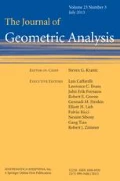Erratum to: J Geom Anal DOI 10.1007/s12220-011-9249-1
Since Sect. 7 of [1] is very technical, we want to make two points more precise:
In Sect. 7.3.4, a term is missing in the definition of the quantity 〈f,V 1,2 g〉. It should read

Section 7.3.8 introduces the set \(\operatorname {fr}(S)\), defined as the union of the boundaries \(\overline{S'}\backslash S'\) of all the children S′ of S. Although clear in Euclidean context, it could well be empty in arbitrary spaces, and the distance to this set be undefined. The corresponding paragraph can be modified as follows:
Fix such cubes Q and S, and note that l(Q)<l(S). For any cube R strictly contained inside S, we know that \(\phi^{1}_{S} \) is constant over R. In the following, let us denote by S Q the unique cube of length δl(S) containing Q. First, if Q∩S=∅, and ρ(Q,S)>δ −N−1 l(Q), then one immediately sees that all the \(\beta^{N}_{Q,S,R}\) are equal to zero, and \(\gamma^{N}_{Q,S}\) as well. Next, if Q⊂S and ρ(Q,S Q c)>δ −N−1 l(Q), then if \(\beta^{N}_{Q,S,R} \neq 0\), it implies ρ(Q,R)≤δ −N l(Q), and thus R is in the same child of S as Q. Therefore, for all the \(\beta^{N}_{Q,S,R}\) not equal to zero, \([ \phi^{1}_{S} ]_{R}\) has the same value, and \(\gamma^{N}_{Q,S} = [ \phi^{1}_{S}]_{Q} \sum_{R}{\beta^{N}_{Q,S,R}} = 0\). Finally, the only cubes Q for which \(\gamma^{N}_{Q,S} \neq 0\) are the cubes Q disjoint from S, at distance less than δ −N−1 l(Q)≤δ −N−1 δ N+3 l(S)<l(S) from S (which implies ρ(Q,S Q c)≤δ −N−1 l(Q)), and the cubes Q⊂S such that ρ(Q,S Q c)≤δ −N−1 l(Q).
Further appearances of \(\operatorname {fr}(S)\) can be modified according to the changes above.
We thank Tuomas Hytönen for pointing out these items.
References
Auscher, P., Routin, E.: Local Tb Theorems and Hardy Inequalities. J. Geom. Anal. doi:10.1007/s12220-011-9249-1
Author information
Authors and Affiliations
Corresponding author
Rights and permissions
About this article
Cite this article
Auscher, P., Routin, E. Erratum to: Local Tb Theorems and Hardy Inequalities. J Geom Anal 23, 375–376 (2013). https://doi.org/10.1007/s12220-012-9296-2
Received:
Published:
Issue Date:
DOI: https://doi.org/10.1007/s12220-012-9296-2

